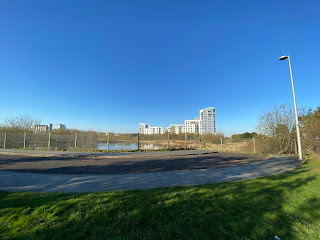This week I went up to Edinburgh for work. Usually I stay in the New Town, which is lovely, but this time (mainly because I drove up rather than took the train), I stayed down by the old docks on the southern shore of the Firth of Forth. Rather like London’s Docklands, Edinburgh’s dock area has undergone significant redevelopment in the past few decades; the former industrial dock area now boasts modern apartment blocks and so on. Leith has, by all accounts, been gentrified.
I was staying at the approximate point where Leith meets Newhaven. As I was there for work and work is further along in Granton, my commute became a rather nice seashore walk. I was glad I took my binoculars and bird book.
Down on the shore were various waders; those very distinctive Oystercatchers, a dozen Knots in winter plumage (surely a bit late for them?), a few Turnstones looking for food among the gulls, a couple of Redshanks and a few small ones which weren’t Turnstones. Waders aren’t my strongest suit by any means, but I was determined to figure out what these ones were. Black legs and bill, grey-brown back, white underparts. Dunlin, I reasoned — like the larger Knots, still in their winter plumage.
Close to my hotel was Lighthouse Park, located on the small peninsula of land that was originally the western breakwater for one of the docks that comprises the Port of Leith. By the early twenty-first century this was the site of some property development comprising of apartment blocks, presumably rather pricey. This development, called Western Harbour, stalled in 2008 as a result of the financial crisis, with some of the planned sites undeveloped save for some access roads and half-dug foundations. Fascinatingly, nature has taken over at these places, now known as the Western Harbour Ponds. I spotted a Mute Swan, a pair of Mallard and many Goldfinches.

Fenced off, these areas have rewilded — what were would-be building sites are now a cluster of small wildlife havens, within easy reach for local residents keen to appreciate nature. Two of them are in fact ponds, while the other two are wooded. Alas, a sign on one of the fences proclaimed that they are currently at risk — property developers are once again interested in the area, for obvious reasons. But it looks as though some local people would like to keep the Western Harbour Ponds as they currently are — and a good thing too. Green spaces are an important thing in the modern city.

The
Friends of Western Harbour Ponds website describes the Ponds as “a wonderful example of urban rewilding — a haven for native plant life, insects, bats and waterfowl … It has also become a very special place place for local residents and birdwatchers, who come to reconnect with nature, watch the wildlife and enjoy the tranquility of this ad-hoc blue-green space in an otherwise densely populated part of the city”. This visitor from London certainly enjoyed a few moments of tranquility before walking to work. I signed the online petition on the spot.
But my birding was not over yet! Looking out to sea, I saw something white and swimming. Another gull? There are many, many Herring and Lesser Black-backed Gulls around! But this looked to be something different. Always worth a closer look. Good job I brought my binoculars.
Turned out, it was a male Eider! Fantastic spot. His female counterpart surfaced while I was looking. I have only seen Eiders once before, and that was a couple of years ago and not far from Edinburgh (just along the coast at Yellowcraig Beach), but I had not thought I’d see a pair at Leith docks. The following morning, just to show that this was no one-off, there were two pairs of Eiders swimming in Newhaven Harbour.
A rewarding visit to a part of Edinburgh not previously explored! An area I’d definitely like to return to; I just hope that the Western Harbour Ponds will still be there when I do.








